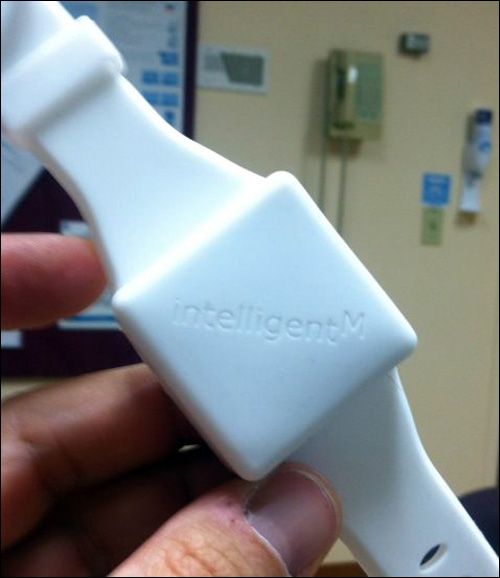Hand-hygiene compliance technology startup IntelligentM has developed a solution that employs radio frequency identification readers built into wristbands to identify tags on soap dispensers, intravenous (IV) solution packaging, surgical drains and ID badges, thereby alerting users if they fail to wash their hands, or need to do so more thoroughly. The system also collects data for business analytics, and shares that information with a hospital’s management and staff every week. A medical facility in Sarasota, Fla., has been testing a prototype of the solution since December 2012, the company reports, and several other Florida hospitals are expect to begin using a commercial version as well, during the coming months.
The IntelligentM system’s founders sought to provide a hand-hygiene compliance solution that would be easy to install and would not disrupt the hospital’s existing infrastructure or IT network, says Seth Freedman, IntelligentM’s president and cofounder. RFID readers installed at hand-washing stations typically must be wired, he explains, and are expensive. For that reason, Freedman’s company opted to design a system whereby users would wear wristbands incorporating very small readers that would interrogate passive RFID tags installed on sinks, disinfectant dispensers and other objects. The wristband reader can issue real-time alerts to a wearer, and also store the details of each RFID read event. A user can then upload that data to IntelligentM’s server when his or her wristband is recharged at the end of the shift. IntelligentM provides the data with some analytics to its clients via a Web-based dashboard, and sends weekly hand-hygiene “report cards” to employees.

Approximately two years ago, the new company began interviewing epidemiologists and infection-control specialists, and thus identified the functions most necessary when it came to hand-hygiene compliance technology. In developing the solution, Freedman says, the firm wanted to be able to provide alerts that would lead to corrective action being taken before a patient was exposed to potentially infectious materials, as well as report data regarding each health-care worker’s compliance.
The wristband comes with a built-in high-frequency (HF) 13.56 MHz RFID reader complying with the ISO 14443 standard, as well as a motion sensor and a rechargeable battery. The wristband’s urethane exterior is blended with a silver ion material that makes its exterior surface antimicrobial. The wristband is designed to be small enough so as not to be cumbersome to users who may also be wearing and removing rubber gloves.
Typically, an IntelligentM RFID tag would be attached to a nurse’s employee ID badge. The company’s server software would store that individual’s identity, along with the ID number on her badge tag. Upon picking up a wristband from the charger at the beginning of each shift, the nurse would hold the wristband next to her badge tag, and the wristband would store that ID, thereby indicating who was using it. If the nurse forgets to link her own badge ID with the wristband, the reader vibrates three times, reminding her to do so.
When the nurse places her hand under a tagged sanitizer or soap dispenser, the wristband reader interrogates the tag mounted there. Based on that particular tag’s ID number, the wristband reader’s internal software then determines the hand-washing station’s locations and surmises that the user is preparing to wash her hands. The reader vibrates once, reminding the wristband bearer to wash her hands, and indicating that it has read the dispenser’s tag. If the band detects that she has stopped washing her hands before the proper amount of predetermined scrubbing time has elapsed, or has not employed the correct hand motion for compliant surface coverage of the sanitizer or soap, the wristband vibrates three pulses, thereby prompting her to wash her hands a second time using the proper procedure.
When the nurse meets with a patient and begins a procedure, such as opening an IV package, a tag on that package is read and the system again identifies the action based on the tag’s ID number. The wristband’s software checks its database to determine the last time this worker had washed her hands. If it was not recent enough, the tag vibrates three times to indicate she must wash her hands before continuing the procedure.
At the end of the shift, the user plugs the wristband into the charging station, which then uploads the data to IntelligentM’s cloud-based server, where the information is interpreted and stored. At the end of the week, IntelligentM can forward the accumulated data, including analytics, to the hospital’s managers. Management can then determine, for example, which departments have the best compliance score, and which individuals may require additional education. Once a week, users also receive an e-mail indicating their seven-day compliance score.
“The technology is intended to be used as a tool,” Freedman explains, rather than to provide a punitive system that gets employees in trouble with their supervisors. Because hospitals are required to report their hand-washing compliance to agencies, he says, the technology can also be utilized to make that process automatic.
According to Freedman, IntelligentM manufactures its own hardware at several sites within the United States. The company provides the solution under a three-year service model, charging a one-time installation fee and about $10 per wristband user per month, for use of the technology and the data obtained from it. Most systems, he notes, could recoup the cost within a few months by preventing a single infection (based on the average cost to treat such an infection—$50,000).
Freedman says his firm examined the use of ultrahigh-frequency (UHF) technology as well as HF, but determined that UHF would have needed to be customized in order to operate as necessary.

